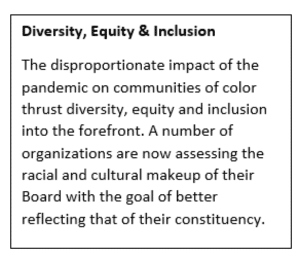Updated July 26, 2023
With ongoing concerns about economic recession, it is tempting to put strategic initiatives on the back burner. It may seem counterintuitive, but now is the ideal time to revisit your Board of Directors (Board) and determine if your organization is compliant and operating optimally. An effective Board is essential for surviving tough economic times, fulfilling the organization’s mission, and providing the leadership needed to seize scarce opportunities to thrive and grow.
Effective Board Governance
During the pandemic, many organizations completely redesigned how they operate, implementing virtual programming, online fundraising events, and supporting hybrid work environments. Most nonprofits who made a successful pivot during COVID-19 leaned on their Board for guidance and support. Unfortunately, many challenges still lay ahead. For their Board to continue providing effective leadership, organizations should conduct regular health checks of their governance structure to ensure that proper policies, procedures and practices are being followed and adequate checks and balances in place.
The Board Governance Assessment
A board governance assessment is much more than just a reinforcement of the organization’s bylaws and board governance manuals. The goal of this exercise is to review the Board’s governance structure to identify strengths, weaknesses, risks, and opportunities, and to advise the Board regarding current best practices related to nonprofit governance.
A board governance assessment looks at several key performance indicators (KPIs):
- Board composition and structure
- Roles and responsibilities
- Board member engagement
- Program understanding
- Strategic planning
- Risk
- Advocacy
- Fundraising
- Financial oversight
- Diversity, equity, and inclusion
Example Board Governance Assessment Specifications
During a board governance assessment, the organization is guided through an examination of several areas:
- Review key governance documents (e.g., Board bylaws, agendas, meeting materials, past meeting minutes, committee structures, and committee charges).
- Review Board policies and make recommendations about policy gaps, potential policy updates, and to advise on policies that may be redundant or potentially open the organization to risk, or policies that the Board might consider adopting to strengthen the organization.
- Attend (virtually) one Board meeting. Based on observation and review of past meeting documents, advise the Board on possible changes to meeting structure/process.
- Conduct an internal survey of the Board and key leaders to determine perceptions of effectiveness. This will include board performance, culture, engagement, governance, leadership, and structure.
- Review the Board’s annual self-assessment process and provide recommendations on future assessment tools and processes.
- Review Board bylaws and advise the Board on best practices.
- Provide a findings report with recommendations and make a closed-session presentation to the Board with findings.
Regular assessments should be a best practice every nonprofit follows to ensure good governance. Following a board governance assessment, an organization can confidently demonstrate to donors, funders and other stakeholders that any deficiencies identified have been addressed and the governance structure is adequate to support the organization through tough decisions and difficult financial times.
For more information about the benefits of board governance assessments, view our Internal Audit solutions page or contact Melissa Musser, CPA, CITP, CISA, Partner and Director, Risk & Advisory Services, at the contact info below.

